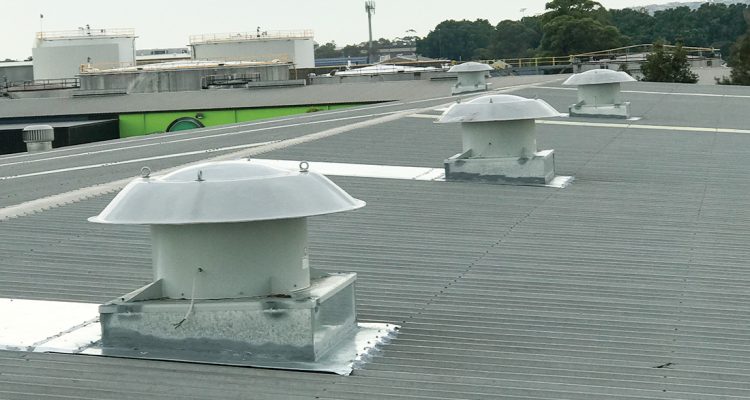Australia’s harsh climate can be unforgiving, and when working in industrial environments, it is crucial to ensure adequate cooling and ventilation systems are in place. Whether it is an enclosed warehouse or factory setting, steel structures tend to amplify heat internally, contributing to worker fatigue. Hot air may also build up from machinery, and with nowhere to go it will become stagnant, creating the perfect environment for particle pollution.
Cooling systems are necessary to keep these workplaces safe, particularly in the warmer months, however installing robust ventilation can significantly assist in keeping temperatures down, and promote better quality air as it cycles through the internal space.
Additionally, installing ventilation fans to extract hot air from a building can help to mitigate this build-up, and reduce the level of cooling needed from air conditioners or evaporative coolers. The running cost of extraction fans are lower, and – if powerful enough – they can do the heavy lifting of keeping the environment at a safe temperature.
Industrial ventilation can be approached in a number of different ways. For smaller spaces, opening a window might be enough to promote circulation, however larger warehouse or factory settings require further consideration. There are two types of mechanical ventilation that can be used in this instance.
Dilution ventilation
Dilution ventilation is usually employed to circulate air out of large areas and entire work sites or plants. Essentially it works to dilute air that has become contaminated with substances such as dust, welding fumes, or smoke, with fresh air using a device such as an exhaust fan.
Local exhaust method
The local exhaust method captures contaminants directly at the source, before expelling them outside of the immediate work area. This is usually used in applications where high volumes of dust, fumes, of toxic contaminants are being expelled from processing equipment.
Any type of mechanical exhaust apparatus involves two basic systems – one to remove contaminated air and one to bring in clean, healthy air to the internal space. The features and structure of an exhaust fan will depend on its specific application, but might include a hood, louvres, transport ducts, filters, or dust filters.
There are both fitted and portable options available on the market, but when it comes to fitted systems there are three common approaches – wall exhaust fans, inline ventilation fans, and hooded roof fans. In Australia, hooded roof fans are best used in conjunction with a robust cooling system, to maintain safe working temperatures and adequate air quality at all times.
The collection of hooded roof fans from Fanmaster boast superior extraction capacity, and are available in 400mm, 600mm, 800mm with kilowatt variation to best suit any industrial application. Constructed with a robust steel body and a weatherproof aluminium cap, these fans can be hardwired into existing duct systems, can extract heat, smoke, dust and fumes at an accelerated rate, helping to avoid stagnant air and keep temperatures down.
Worksite auditing from a Motion Australia representative can aid in selecting the most efficient and cost-effective exhaust options available. As a wholly Australian owned business, Fanmaster has over 75 years of expertise behind their designs, offering comprehensive product advice and servicing to customers across various industrial sectors.
Did you know?
According to the Australian Department of Agriculture, Water, and the Environment, short and long-term exposure to harmful pollutants can negatively impact the heart and lungs, potentially leading to cancer or other serious health concerns. People with pre-existing conditions are more likely to be sensitive to factors like welding fumes, dust particles and smoke emitted by processing equipment on industrial sites.
Source: www.awe.gov.au

